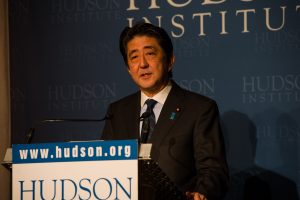Japan’s state broadcaster reported earlier today that the country’s Prime Minister Shinzo Abe will step down due to health reasons. A nationalist with penchant for thinking big, Abe set the record for holding the position for longest consecutive terms. He leaves behind a rich legacy in the Asia-Pacific, helping set the geostrategic agenda for the region in face of growing Chinese aggressiveness. As a leader of a nominally-pacifist nation, Abe has been instrumental in helping push the normalization of Japan’s complicated relationship with military power.
Widely seen as the architect of the “quad” – a four-nation strategic consultation framework involving the U.S., Australia, Japan, and India – Abe’s tenure saw Tokyo cultivate deep relations with New Delhi. Most significantly, Abe led the way for the emergence of the “Indo-Pacific,” an expansive geostrategic construct which seeks to manage the Indian Ocean and the Western Pacific as a single integrated theater.
Abe’s resignation comes amid a growing debate in Japan around the extent to which the country should arm itself, given Japan’s post-World War II pacifist tradition. In its latest episode, over the past few weeks Asia watchers have debated Japan’s need for an independent offensive strike capability – “enemy base attack,” in Tokyo’s parlance. The extent to which this square with Article 9 of the Japanese Constitution has also been a subject of scrutiny. While, as Daisuke Akimoto wrote in The Diplomat, the argument for strike capabilities date back to as early as 1956, Abe had been instrumental in pushing this idea. The churn in Japan’s strategic thinking has manifested itself in unexpected ways. Abe’s government had also announced in early June that it will not go ahead with the deployment of the Aegis Ashore ballistic missile defense system — which analysts have argued –would have benefited the U.S. as well.
In 2012, Abe proposed what later began to be called the quad. In an article rich with strategic ideation, he wrote: “I envisage a strategy whereby Australia, India, Japan, and the US state of Hawaii form a diamond to safeguard the maritime commons stretching from the Indian Ocean region to the western Pacific.” Over the last couple of years, the quad has emerged as a key consultative mechanism to triangulate emerging challenges in the Indo-Pacific. In a 2007 speech in the Indian parliament Abe spoke of the “Confluence of Two Seas,” the Indian Ocean and the Pacific. This later morphed into his “Two Continents, Two Oceans” proposal where Africa and Asia would be linked together as a single economic and strategic entity. In order to give shape to this idea, Japan and India committed to develop a maritime Asia-Africa Growth Corridor in 2016 as an alternative to China’s Belt and Road Initiative (BRI) even when Japan continued to shrewdly hedge its bets when it came to the BRI.
India – and especially the country’s current Prime Minister Narendra Modi – had found a vital partner in Shinzo Abe’s Japan. Abe pushed for a much closer security relationship between the two countries. Together with the United States, the Modi government has accorded a pride of place to JAI – Japan-America-India – as a strategic coalition. (A clever moniker, JAI means “victory” in Hindi.) Modi and Abe were supposed to meet over a virtual summit in September to sign a military logistics agreement along the lines India has with the U.S., South Korea, Australia, Singapore and France. Taking stock of the India-Japan defense relationship for The Diplomat, Rajeswari Pillai Rajagopalan noted that it remained strong despite modest setbacks.

































